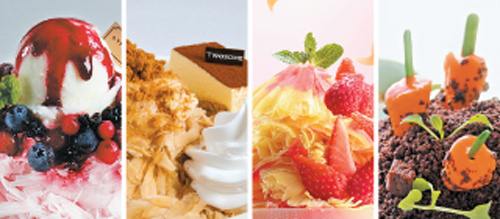A frozen treat takes on curious new forms

From left: A Twosome Place’s Omija Ice Flakes with Lemon Sherbet and Cold Brew Ice Flakes with Cake, Paris Baguette’s Flower Bingsu, and Park Hyatt Seoul’s Carrot Chocolate Bingsu sold at The Lounge. [A TWOSOME PLACE, PARIS BAGUETTE, PARK HYATT SEOUL]
In recent years, bingsu makers have started releasing the icy delicacy as early as April, months before the official start of the summer. Paris Baguette, a popular Korean bakery chain, began selling bingsu in March this year.
“As the summer heat arrives faster and lasts longer, consumers are demanding bingsu earlier than before,” said an industry expert.
In the past, bingsu ice was made of either water or condensed milk and was white or translucent. The ice, which makes up the majority of the dessert, is usually served shaved as soft and creamy snow-like flakes.
This season, cafes are trying to win over customers with colored shaved ice offered in funky flavors.
A Twosome Place, for example, launched four different kinds of bingsu this spring, each with their own flavors and colors. While the Red Bean Ice Flakes are made with plain ice, the Omija Ice Flakes with Lemon Sherbet have a reddish tint from omija, a type of berry. The Cold Brew Ice Flakes with Cake contain ice made with cold-brew coffee, and the TWG Black Tea Ice Flakes are made with black tea.
“This year, we focused on designing ice that would emphasize the chill factor, one of the most important features of bingsu,” said a spokesman for A Twosome Place. “By accentuating the color of the ingredients, we tried to create visual appeal.”
Paris Baguette released its Flower Bingsu this month. Its shaved ice, made with mango and strawberries, comes in swirls of pink and yellow. Cafe Pascucci and Angel-in-us also launched new bingsu this year that use milk tea as their main ingredient to create brown-hued shaved ice.
“Whereas before we tried to differentiate bingsu using various kinds of toppings, now we are trying to be creative with ice, which makes up 80 percent of bingsu,” said a Paris Baguette spokesman. “Going one step further from condensed milk, more businesses are making bingsu ice using more diverse ingredients, like fruits and tea.”
But the shift in focus to ice doesn’t mean that dessert makers are neglecting toppings. New bingsu flavors are coming out every month with unique toppings. This year’s top trends are sweet and savory - and many are adding vegetables to the mix.
The Park Hyatt Seoul launched its Carrot Chocolate Bingsu this year. It’s a novel combination of Valrhona’s premium French chocolate and carrot juice extract.
“We tried to subdue the sweetness of the chocolate with carrots instead of fruits,” said Lee Jae-jin, a pastry chef at the hotel.
Damkkot, a cafe that specializes in traditional Korean desserts, released two new savory bingsu last month. One is draped with avocado slices and the other is covered in tomato jam.
Hollys Coffee released its Corn Cheese Cake Ice Flake this month as well. It’s made with cheesecake, corn kernels and vanilla ice cream.
“Because we now sell bingsu for almost half a year instead of just one or two months in the summer, it’s become more important to differentiate products [through ice and toppings],” said an industry expert.
“Not only do we have to offer great-tasting bingsu, but we have to take into account social media marketing that happens through Instagram and other channels. More businesses will experiment with ice and toppings to produce bingsu with a colorful and unique appearance.”
BY KANG NA-HYUN [kim.eunjin1@joongang.co.kr]










with the Korea JoongAng Daily
To write comments, please log in to one of the accounts.
Standards Board Policy (0/250자)